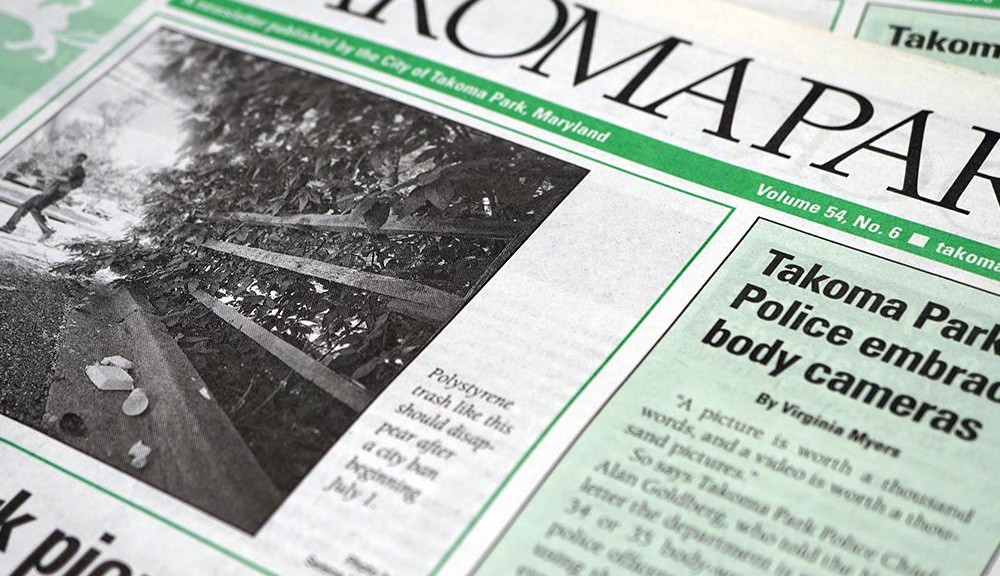By Helen Lyons
English Ivy, Wintercreeper, Porcelainberry, Bush Honeysuckle and Multiflora Rose – these are some of Takoma Park’s most common and visible plants, climbing the sides of brightly painted bungalows and decorating the yards of 1930s brick homes. But they’re also invasive, and some of the most aggressive non-native plants to dominate the neighborhood landscape.
“The invasive species, aggressive ones especially, don’t let the native species grow,” said botanist and Takoma Park resident Gorky Villa Muñoz. “There is a small threshold for change between animals, insects and plants. If insects use a plant to pollinate other plants and that plant disappears, the insect population can disappear.”
Villa Muñoz is a staff botanist at Finding Species with over fifteen years of field experience identifying plants. He joined a group of volunteers from Friends of Sligo Creek, as well as nearby neighbors, in trying to clear some of these invasive plant species from Dorothy’s Woods as part of Takoma Park’s Martin Luther King Jr. Day of Service.
“Japanese honeysuckle, multi-flora rose, English Ivy or hedera helix – it’s so invasive that it’s more damage control than removal,” said Luc Phinney, a volunteer who lives close to the woods and came to help with the project. He estimates that many of these plant species, while not native to Takoma Park, have been here for over a century.
“Japanese honeysuckle, multi-flora rose, English Ivy or hedera helix – it’s so invasive that it’s more damage control than removal”
“Some of them are long-term problems, things that came in with European settlement or trade with Asia- a hundred years ago, two hundred years ago,” said Phinney. “Some of them are more recent, and sadly, some are even from people’s gardens, [like] Bush Honeysuckle.”
Fliers on hand at the clean-up, produced by Friends of Sligo Creek, warned that “non-native invasives crowd out native plants and could be spreading from your yard.”
Among the culprits are Mile-a-Minute, a vine with triangular leaves and bright blue-black berries in the summer; Norway Maple, a tree with spiny leaf tips; Bittersweet, a vine with drip-tip leaves that gets orange berries in the fall; and the beautiful Bush Honeysuckle with its yellow flowers so often planted along the borders of Takoma yards.
Removing the plants isn’t easy. Phinney used a special device called a Pullerbear Tree Puller Tool to give him the leverage needed to yank up the root of a Kudzu plant, which can get as thick as four inches according to the Forest Invasive Plants Resource Center. Vines on the ground will set roots at the leaf nodes, creating more Kudzu plants that are capable of growing a foot a day.
It’s hard work, but if the invasive plants aren’t controlled, they could take over the woodland and kill the native species. “Even a small break in the chain of what is natural can cause problems,” Villa Mu- ñoz said.
After hours of back-breaking work at Dorothy’s Woods, the flora was visibly improved and children set off to play in the forest, which was officially christened on Oct. 23 last year and named after long-time Takoma Park resident Dorothy Barnes, 94, who has lived next to the woods for most of her life.
But beyond the stretch of woods at the intersection of Woodland Avenue and Circle Avenue, invasive species are still running rampant in Takoma, stifling the growth of native plants and killing trees that have stood for decades or longer. Friends of Sligo Creek offers assistance in plant identification, removal techniques, and ideas for native replacements. Residents seeking help in removing the invasive non-native plants from their yards can visit www.fosc.org for more information.
This article appeared in the February 2017 edition of the Takoma Park Newsletter. The Takoma Park Newsletter is available for download here.

